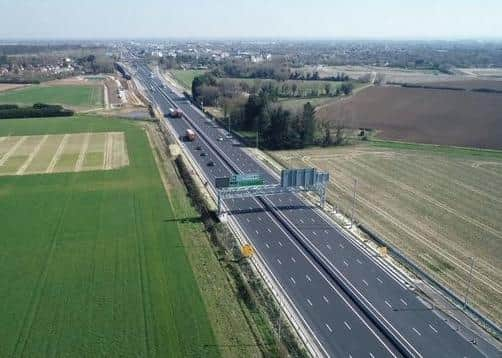A14 improvement scheme: Series of problems identified
This article contains affiliate links. We may earn a small commission on items purchased through this article, but that does not affect our editorial judgement.
and live on Freeview channel 276
A new bypass opened to traffic in May 2020 - eight months ahead of schedule - and is said to have provided a “significant improvement” according to a new report by Cambridgeshire County Council, which has taken over as the responsible highway authority.
However, the council said three main areas of concern have been raised relating to traffic.
Advertisement
Hide AdAdvertisement
Hide AdThis includes the B1043 between the Alconbury junction on the A1 and Alconbury Weald seeing a “considerable increase” in HGVs which is thought to be due to the A14 moving to the south of Huntingdon leading to traffic wanting to head east on the A14 now using the A1 from Alconbury Weald.


Improved signage and meetings with local businesses and parishes are said to be planned, but “damage to properties on the Lordsway Park from debris and undesirable litter thrown from vehicles continues to cause significant issues for residents”.
In addition, there have been reports of higher traffic volumes on the A1123 between Huntingdon and St Ives, as well as the B1040 through Hilton, particularly from HGVs in the former.
High volumes using routes through Huntingdon itself have also been reported and are being investigated by Highways England, with the hope that this will be resolved once new links in Huntingdon open up.
Advertisement
Hide AdAdvertisement
Hide AdMoreover, there are concerns over the lack of provision of a safe crossing point at the old A14 (now called the A1307) between the New Barnes Lane and Cambridge Road Fen Dayton junctions as there is an existing gap in the central reservation.
A bridge funded by Highways England will not be provided due to “the relatively small number of users versus the high cost of a bridge not creating a feasible business case”.
Further issues have also been raised elsewhere south of the county, while the report also adds: “There are some significant environmental health concerns that have been expressed by residents of communities living close to the A14 at and between Junctions 32 (Histon) and 33 (Milton).”
Highways England will now carry out an overall assessment of the scheme from March 2022 which is expected to take around six months to complete.
Advertisement
Hide AdAdvertisement
Hide AdIn addition, the council report highlighted that during closures while the project was ongoing, roads which were “unsuitable” (particularly for HGVs) were used as a diversion.
The report states: “This caused significant disruption for some communities living along the corridor and has also left a lasting negative legacy, as the condition of many of these roads has deteriorated significantly due to this unsuitable volume and type of traffic.
“The county council has been working closely with Highways England over this issue and, despite initial positive signs that some work could be funded by Highways England, it has been confirmed that this is now not possible.
“Both the county council and Highways England subsequently raised the issue with the Department for Transport (DfT) and, whilst receiving an initial positive response that funding may be able to be made available, the DfT have not yet been able to establish any available funding.”
Advertisement
Hide AdAdvertisement
Hide AdThe new bypass was part of a £1.5 billion project to upgrade 21 miles of the A14 between Cambridge and Huntingdon.
The report concludes: “There are clearly a number of lessons to be learnt from this extremely large infrastructure scheme and numerous sessions have already taken place between Highways England, the A14 Integrated Delivery Team and county council officers.”
More information on the damage caused to the local road network can be found on page 129 here.